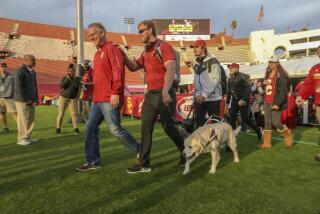Pups Born and Bred to Become Guiding Eyes : Blind Become the Owners of Special Dogs at Canine Graduation Ceremony in Sylmar
- Share via
The class sat quietly, waiting for the awards ceremony to begin. For 10 canines, this graduation day marked completion of nearly two years of intense training to qualify them for their future careers, serving as guides and companions for their blind owners, who stood beside them.
It was a sunny day on the terrace of the headquarters building at International Guiding Eyes Inc., a Sylmar-based organization occupying a six-acre estate against the foothills of the Santa Susana Mountains at the northern end of the San Fernando Valley.
Friends and relatives sat in the audience as recipients and their new guide dogs were introduced. They had come from various sections of California and as far east as Maine for a required 28-day stay during which they learned to work and live with their new charges.
Behind each dog is a meticulously planned program that begins when puppies are born here in International Guiding Eyes kennels.
“We use 70% Labrador retrievers, 20% golden retrievers and 10% German shepherds,” said Holly Melvin, who supervises breeding. “Labradors are very stable and adaptable. They’re short-coated, easy to groom, and have few medical problems compared to other breeds.”
The future guide dog begins its schooling at 6 weeks of age when the puppy goes to a foster home. Jane Brackman, a motion picture producer who lives in Altadena, is a volunteer for Guiding Eyes who is currently raising a golden retriever that she will return when it is 15 months old.
“The purpose of the foster home is to give the future trainer a good foundation to work with,” she said. “We have 100 dogs in foster homes right now, and we’re always looking for volunteers. We expect the dog to return with basic house manners and to have learned obedience.
“The dog we’re raising at home is named Ruth. We give them adult non-dog names that are easy to pronounce, preferably one syllable. At dinner time Ruth lies under the table, and she doesn’t beg for handouts. I’ll take her into a grocery store--she’s wearing a special jacket that identifies her as an International Guiding Eyes trainee. We’ll walk past the meat counter. A dog can pick up the scent immediately--some would start yipping. Ruth ignores it. This is part of her basic training.”
Many would find it impossible to give up a dog after raising it from puppyhood and it is difficult for children to part with them.
“We have an outlook that overcomes this,” Brackman continued. “It’s something we tell children in the families, and you’d be surprised how readily they accept it. It’s that the dog they have helped raise is going to provide eyes for a person who lives in a world of darkness. It will be a devoted companion and will help its owner lead a productive life.”
As the dogs return to their Sylmar base, the graduate course begins. Lee Mitchell, training manager, assigns one or more of his staff to each dog to begin the tutoring process. They include Maurice Hall, Ron Rini, Jeff McMullen and Jonathan Lunkry. The future guides are taken into the crowded and noisy atmosphere that a blind person often must confront: shopping malls, downtown Broadway or the Union Station.
In a Valley department store, the dog learns to ride calmly on an escalator or enter an elevator packed with shoppers. The guide dog will face the elevator door and sit down. Day after day for as long as six months the curriculum will continue. Walking along a street, the dog learns to be observant in four directions; up, down and to each side. They’ll walk their owner around any obstacle--a rock, a crack in the pavement, an overhanging rosebush. When crossing a street, if the blind person signals the dog to go, it will disobey if there is oncoming traffic.
At scheduled intervals, the new owners arrive to accept their dogs, generally in groups of 10. About 50 dogs and owners are matched each year. All have been screened so that the most suitable dog will be given to them.
“You have to take into consideration the age of the person receiving the dog,” said Hall, a staff trainer. “A younger, more active person would adapt better to a German shepherd, as they move more quickly. The Labradors and goldens are quieter and more suitable for an older person.”
During their stay, those receiving their new guides live in a building that has all the comforts of a resort hotel. Each has a private room with its own fenced-in yard for the dog. Attendants keep it spotless. There are gardens to walk in, a swimming pool for exercise. Meals are served in a dining room and friendships are formed by those participating in the program. After the third day, the dogs are given to their new owners.
International Guiding Eyes Inc. was founded by Joseph W. Jones Sr., who had been turned down for a guide dog because of his age--57. Jones was a machinist who had to give up his job when he was 37 because of failing eyesight, the result of an illness as a child.
Jones presented a plan to establish an organization that would provide guide dogs to the blind without cost to the recipient--and without any age restriction--to the International Assn. of Machinists in Washington. Its executive council endorsed the movement and International Guiding Eyes was incorporated in 1948. Jones died in 1957.
The organization he pioneered makes its dogs available free to applicants throughout the nation. One must be 16 to apply. It receives its financial support from the International Assn. of Machinists, a number of other unions, corporation grants and contributions from thousands of individuals.
Many volunteer their time to run errands, exercise the dogs and perform other chores. The organization receives no state or federal aid. The cost of raising and training a guide dog is $10,000.
Pam Hoytt is one of the volunteers. On awards day she introduced each new dog owner to the audience and told of their ambitions for the future.
“We want the dogs to go to people who are living active lives,” she said, “and in this group today, all of them are. To mention but a few, there’s Tamar Zachs, a student in adult education at San Diego City College. She wants to form a support group for parents of blind children in the San Diego area.
“Bonnie Lyon, who lives in Atascadero with her husband and three sons, is another. She’s working on a master’s degree in psychology to become a marriage and family counselor. Her goal is to obtain a doctorate in psychology and start a Braille Institute in San Luis Obispo.
“There is also Philip Amenta of West Los Angeles. He’s an artist who paints in oils and weaves Indian blankets. He told me he’s looking forward to being viewed as a man with a dog rather than a blind person.”






